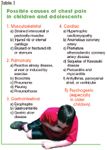Child chest pain: A course of action
Uncovering the origin of chest pain among children requires heightened levels of awareness, and oftentimes, outside intervention.

Key Points
In our very cardiac-conscious society, a child presenting with chest pain usually creates anxiety in his or her parents, who fear for the worst. Despite the family's worries, which can be considerable, the many causes of chest pain are usually benign. In rare cases, however, it can be the harbinger of significant cardiac disease. Pediatricians should therefore complete a preliminary evaluation for chest pain, decide on a differential diagnosis, and if not make a specific diagnosis, at least develop a diagnostic plan to learn its cause. Often a definite diagnosis calls for the aid of an appropriate consultation. With this assistance, a treatment plan can be established.
A variety of sources

By far the most common cause of chest pain among children is musculoskeletal injury.1,3 Children can easily injure their pectoral or intercostal muscles as well the cartilaginous structures of the immature chest wall in sports, heavy lifting, or even playground activity. In smaller children, this problem is often confounded by the child's inability to clearly state the nature of the problem. Similarly, vague complaints of chest pain are often difficult to separate from abdominal pain-especially in children under six years of age.3(See "A hands-on approach to chest pain assessment" at the end of the article.) Less prevalent causes include those pulmonary in origin, typically a bronchospasm, either at rest or induced by exercise.3
Finally, underlying cardiac problems, while usually rare, can also present as another source for chest pain among children. The focus of this article will be on the differential diagnosis of these cardiac-based etiologies.
Author's note: Non-cardiac causes including gastroesophageal reflux and asthma will not be discussed in this article. But they have been well covered by other authors.1-3
Asking the right questions
As in all diagnostic evaluations, a thorough history is important, even in a young child. The pediatrician should first ask when the pain started, even though the answer is usually a vague "last month" or even "last year." In general, the longer the pain has been present without progression, the less likely it is life-threatening.
Once the pediatrician has established a time frame, the next questions should be about the most recent episode (hopefully, the last episode was in recent memory so the child can describe it well). Ask how long the pain lasted, what made it better, and what made it worse. Was there a change in the pain with arm movement or respiration? Was there trouble breathing? Was the breathing noisy? Was there dizziness? Was the pain caused by any particular activity? If the pain comes at rest, ask whether it was like a pin or a pencil eraser pressing against one area of the chest. Time descriptions are difficult in young children, so using a relationship that they would know, i.e., the length of a TV commercial, can help determine how long the pain lasted.